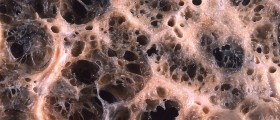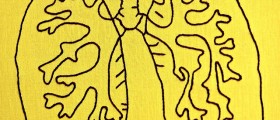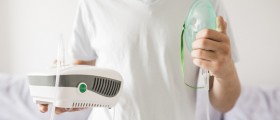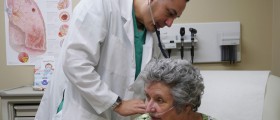
Emphysema in Lungs
Emphysema is a lung disorder during which the airways are progressively impaired resulting in breathing difficulties. Emphysema is one of the chronic respiratory diseases and it is caused primarily by smoking. Emphysema destroys the air sacs by creating gaps in them, which results in lowered lung capacity and reduced level of oxygen that is distributed throughout the organs. Another aspect of the condition includes the destruction of the flaps that keep the air sacs open. As a result the air is captivated in the lungs. The symptoms of emphysema can be treated but the disorder is irreversible. Emphysema often affects both lungs and gets worse over time. The most common signs and symptoms include difficulties in breathing, shortness of breath, inability to sustain physical activity, and coughing. As emphysema progresses, breathing becomes more and more challenging, ultimately making it difficult to participate in everyday activities. It should be noted that emphysema is a serious medical condition which can result in death. The number of deaths caused by lung diseases has been rising for the past few years. Presently, the chronic obstructive pulmonary disorders are the fourth leading cause of death in the United States. Male smokers are more likely to develop emphysema while the number of the female cases has been increasing.How Does Emphysema Occur?
Air pollutants are the primary causes of most lung conditions, including emphysema. In some very infrequent instances the illness is genetic, and the offspring is missing a protein that preserves the stretchy forms in the lungs. Exposure to toxic substances such as coal contributes to the development of respiratory problems. Industrial, marijuana, and tobacco smoke leave the most adverse consequences on the lungs and cause emphysema. When it comes to specific risk factors, long-term smokers are particularly vulnerable to emphysema and the longer they smoke the more likely it is that respiratory illnesses will evolve. It should be noted that smokers are not only putting themselves in danger but are also exposing everyone around them to the negative effects of tobacco smoke. Second hand smoke has been linked to numerous emphysema cases. The older the smoker is the more prone he or she is to lung problems. Middle-aged individuals are the most susceptible to emphysema. Persons who are subjected to chemical vapors or occupational dust are at an increased risk for chronic respiratory problems. It has been established that emphysema can run in a family. More precisely, experts have noticed that if there is a member of the family affected by emphysema, other relatives are more probable to develop the diseases compared to the general population. Also, certain viruses are known to cause infections which can escalate to serious pulmonary problems. Lastly, car exhaust, diesel, and other types of outdoor pollutants make it that much more likely that the exposed individuals will suffer from long-term problems. Further complications from emphysema include heart problems. Chronic respiratory conditions put a strain on the arteries that connect the heart and the lungs. In turn the heart’s functionality and vitality are diminished over time. Collapsed lung is also a potential threat and is characterized by excess air between the chest cavity and the lung. Finally, emphysema gradually reduces the space where the lungs expand.Diagnosing Emphysema
Symptoms and Treatment
The most recognizable symptom of emphysema includes shortness of breath. As a result most people will feel tired and apathetic. Many individuals will experience losing weight without trying, while others will have trouble with the swelling of the legs, feet, and ankles. Coughing is also highly associated with emphysema and other pulmonary disorders. When it comes to treatment as there is no cure the best thing to do is to quit smoking and stay away from polluted areas. Supplemental oxygen and various forms of medications are also often used. In some instances protein therapy will be introduced for those who suffer from the genetic type of emphysema.










_f_280x120.jpg)





Your thoughts on this
Loading...